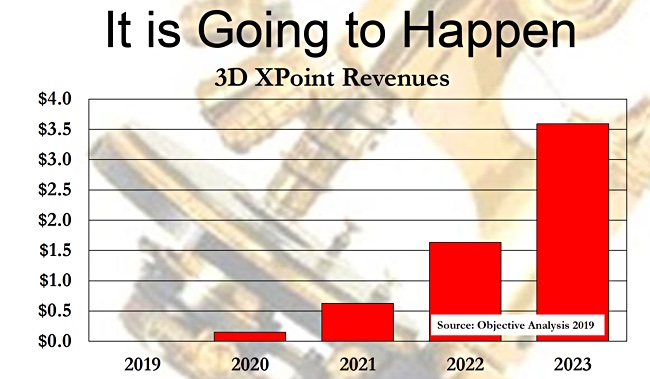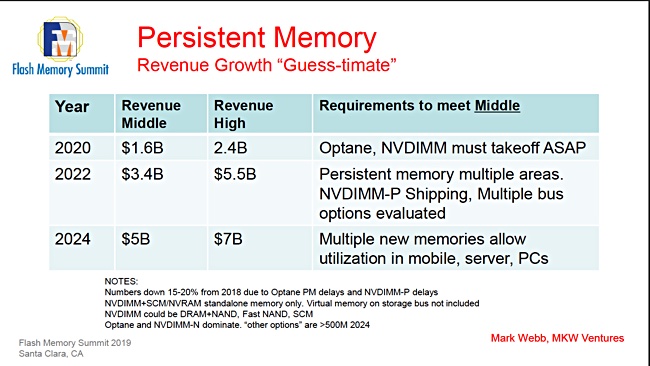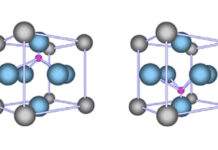3D XPoint media revenues will grow to more than $3bn in 2023, propelled by system software support and lowered manufacturing costs.
XPoint expert analyst presentations at the Flash Memory Summit 2019 in San Jose this month were based on a belief that XPoint is now a viable storage-class memory (also called persistent memory) and sales will take off in 2019 or 2020.
Jim Handy, the memory guy at Objective Analysis, showed a chart of predicted XPoint revenues in his FMS 2019 presentation:

Mark Webb of MKW Ventures Consulting, also showed an XPoint projected revenue table.

Webb looks out a year further than Handy, and includes non-Optane media in 2024. Blocks & Files thought a direct comparison between the Handy and Webb projections would be a good idea. We guesstimated numbers from Handy’s chart and put them into a spreadsheet model.
Webb skipped 2020 and 2022 in his slide but Blocks & Files interpolated numbers in these years by splitting the difference between the previous and following years to arrive at this table;

That enabled us to chart and compare both sets of numbers:

Handy thinks XPoint revenues start quite slowly in 2020 but then accelerates out to 2023. Webb differs with a near-$1bn number this year and then a linear rise out to 2023. At this point, Handy’s projected revenues surpass Webb’s.
Webb and Handy are making best-estimate assumptions about Optane DIMM and XPoint SSD sales; their relationship to Intel Cascade Lake server sales; the ratio of DRAM to XPoint DIMMs in servers; and the entry of Micron into the XPoint market.
They both arrive at $3bn- $3.6bn revenue range in 2023.
Gen 2 XPoint
Intel and Micron are planning for its generation 2 of Optane in 2020, according to Webb. He estimates it will have 4 stacks, instead of Gen 1’s 2, but similar lithography. It will still be SLC (1 bit/cell) but have a 35 per cent lower bit cost with its 256Gbit die than Gen 1’s 128Gbit die.
He said there should be measurable Gen 2 XPoint volume in late 2020.
In Webb’s view Micron will not ramp its own Gen 1 XPoint sales. Its plan is to wait for Gen 2 and then develop its own markets. Blocks & Files thinks that Micron may make its XPoint media usable as memory by AMD processors, also perhaps ARM systems, IBM POWER processors and GPUs.
Webb points out that Micron’s Lehi, Utah plant is the only XPoint fab and will be able to support Intel’s needs and Micron’s initial ramp. It will output 45m GB/month of Gen 1 XPoint in the fourth quarter and 5m GB/month of Gen 2 XPoint. A year later the Gen 1 output will be the same but Gen 2 will have risen to 25m GB/month.
Under the terms of the Intel-Micron joint venture, now being dissolved, Micron is required to provide XPoint capacity to Intel for another year from October 2019. It could agree to provide capacity for longer still, thus saving Intel the cost of developing its own XPoint fab.
With an XPoint fab likely costing north of $10bn to develop from scratch and the Lehi fab capable of of doubling or tripling output Intel could defer building its own fab for some time.
Note. the Handy and Webb presentations scan be found in the presentation set downloadable from the FMS 2019 website.






